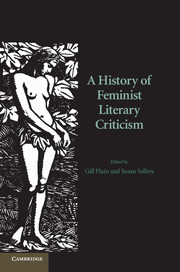Book contents
- Frontmatter
- Contents
- Acknowledgements
- Notes on contributors
- Introduction
- PART I PIONEERS AND PROTOFEMINISM
- PART II CREATING A FEMINIST LITERARY CRITICISM
- Introduction to Part II
- 6 Literary representations of women
- 7 A history of women's writing
- 8 Autobiography and personal criticism
- 9 Black feminist criticism
- 10 Lesbian feminist criticism
- 11 Men and feminist criticism
- PART III POSTSTRUCTURALISM AND BEYOND
- Postscript: flaming feminism?
- Index
Introduction to Part II
Published online by Cambridge University Press: 05 June 2012
- Frontmatter
- Contents
- Acknowledgements
- Notes on contributors
- Introduction
- PART I PIONEERS AND PROTOFEMINISM
- PART II CREATING A FEMINIST LITERARY CRITICISM
- Introduction to Part II
- 6 Literary representations of women
- 7 A history of women's writing
- 8 Autobiography and personal criticism
- 9 Black feminist criticism
- 10 Lesbian feminist criticism
- 11 Men and feminist criticism
- PART III POSTSTRUCTURALISM AND BEYOND
- Postscript: flaming feminism?
- Index
Summary
This section will map the development and the central issues of feminist literary criticism, from the groundbreaking work of critics such as Germaine Greer, Kate Millett and Eva Figes, through the search for a women's tradition and the impact of autobiographical discourses, to the challenges posed by black, lesbian and male feminists and critics. This inaugural work is the product of a crucial period for feminist literary criticism, and from the mid-1960s to the early 1990s it is possible to trace the concept's gradual development from an initial revolt against the androcentrism that had dominated literary studies, to a complex and diverse set of discourses seeking to problematise the assumptions, not only of gender, but also of race, class and sexuality.
As a number of the chapters in this section observe, ‘second-wave’ feminism emerged in the aftermath of, and in conjunction with, a number of radical political movements. For many women – writers, critics, activists – the personal became the political in contexts as diverse as the American Civil Rights Movement and the British Campaign for Nuclear Disarmament (CND). The result of this activist parenting was a critical practice that was always already political, or rather, one that – in contradistinction to the assumptions of commonsense patriarchal humanism – always already knew itself to be political. Not surprisingly, the emergence of such a discourse was dramatic and at times confrontational, and Part II of this volume also seeks to illustrate the excitement that attended feminism's ‘coming out’.
- Type
- Chapter
- Information
- A History of Feminist Literary Criticism , pp. 102 - 104Publisher: Cambridge University PressPrint publication year: 2007

